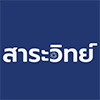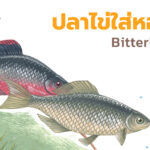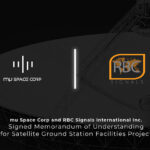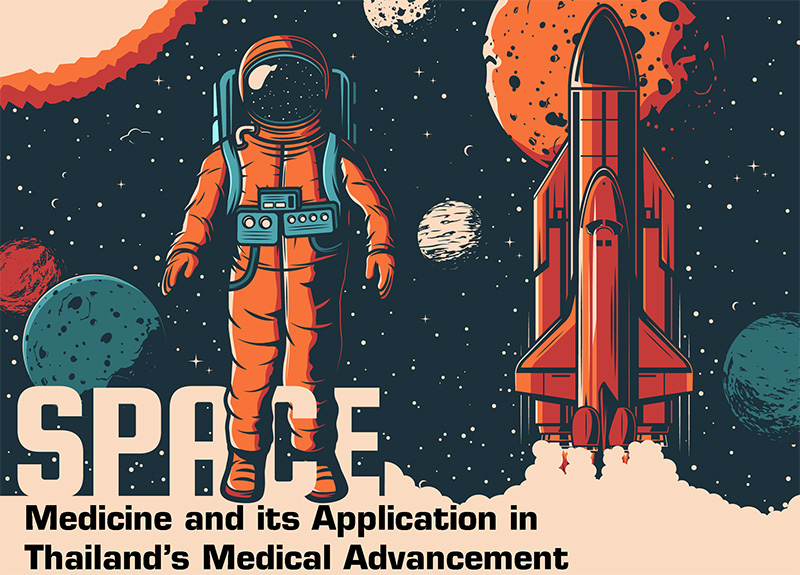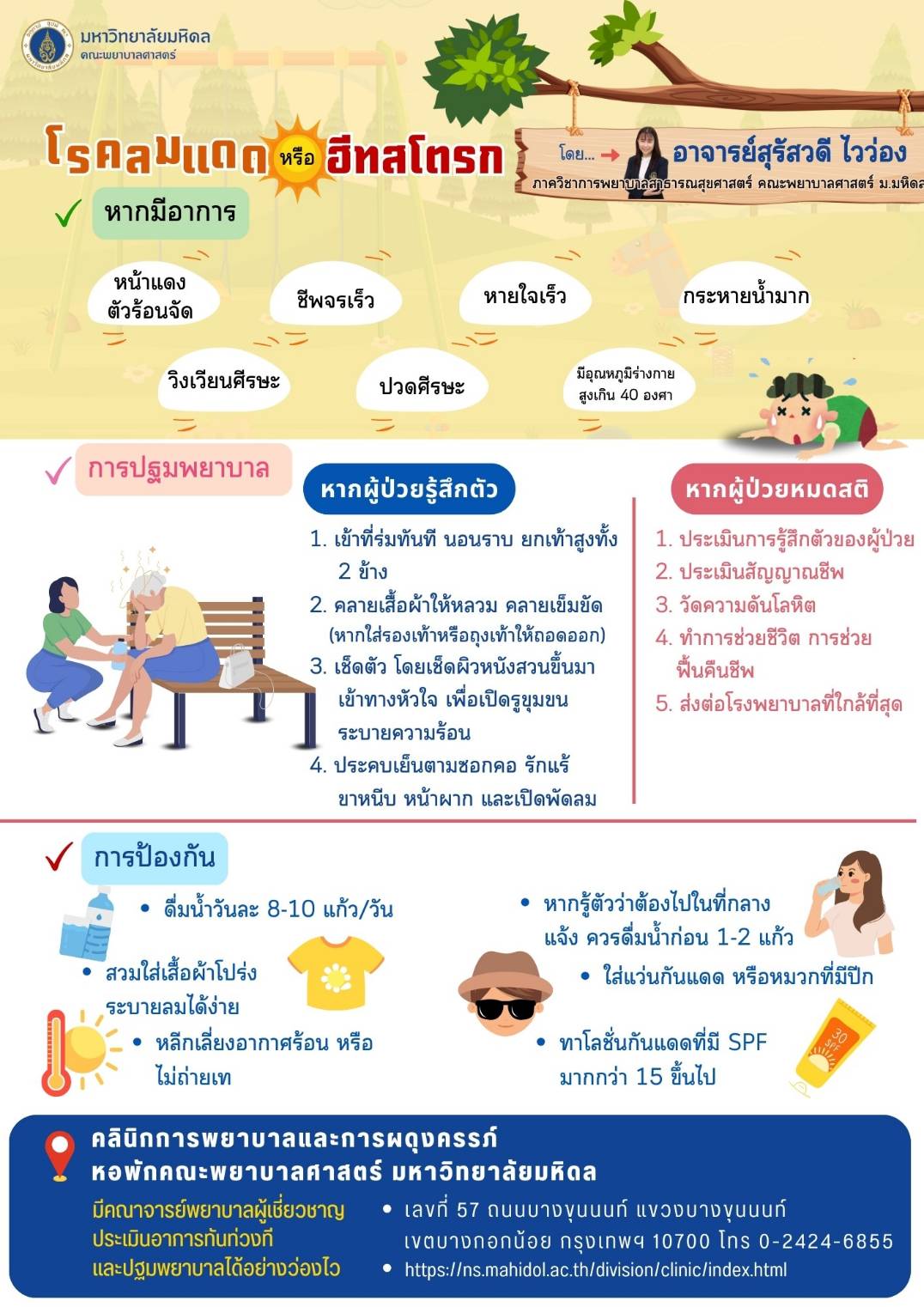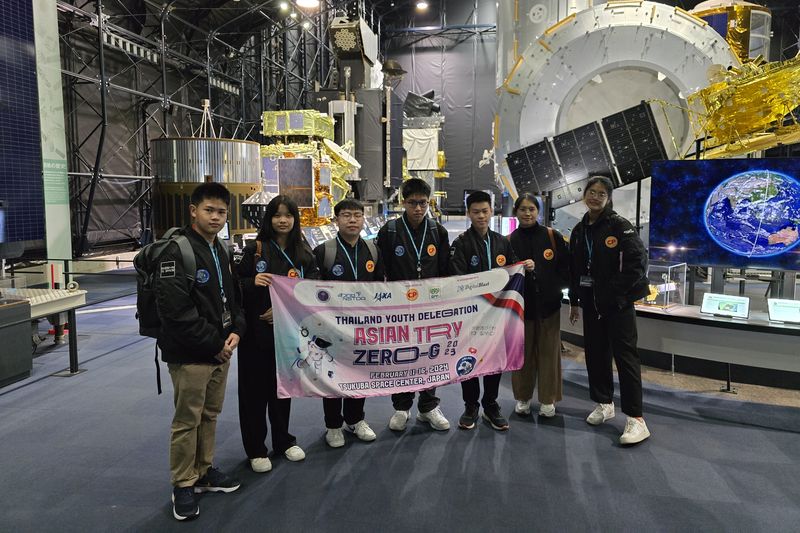Space Medicine and its Application in Thailand’s Medical Advancement
Supitcha Anuwongworavet1, Napatr Wongboonkuakul1,
Nutnicha Rangchaikul1, Wares Chancharoen Ph.D.1,*
1Princess Srisavangavadhana College of Medicine,
Chulabhorn Royal Academy, Bangkok, Thailand
*Corresponding Author Email: wares.cha@cra.ac.th
Abstract
For centuries, space medicine has been a major factor in maintaining the health and well-being of astronauts, who are under prolonged exposure to extreme environments. Due to their impaired immune system and heightened microbial virulence factor, astronauts are highly susceptible to infectious disease. This provides an opportunity to develop a better understanding of related physiology, test drug efficacies, and possibly implement learned strategies to Earth.
Keywords: space medicine, disease prevention and control, drug development, social impact, space exploration
Introduction
April 12, 1961, marks the date humanity set foot outside of the earth’s atmosphere. Even though that particular space flight only lasted for 108 minutes, its accomplishments had opened a new realm of possibilities within the scientific field1. Historically, the United States of America (USA) and the Union of Soviet Socialist Republics (USSR) were the key players in space exploration. However, over time the advancement of technology enabled space exploration to be possible for other countries to conduct their own research. For instance, Thailand launched its first satellite, THAICOM 1, in 19932 and is currently, under the Thai Space Consortium project, planning to launch TSC-Pathfinder, a pilot satellite, within 20233. The amelioration of space exploration correlates with improved technology and understanding of the fundamental principle that governs life on earth. In September 2021, SpaceX launched Inspiration4, the first crewed orbital mission with no professional astronauts on board4. The crew consisted of four members: Jarred Isaacman; a billionaire pilot, Hayley Arcenaux; a physician assistant, Chris Sembroski; a data engineer, and Sian Proctor; a geoscientist and science communication specialist4. Thus, proving that anyone can travel into space. With humanity trying to explore the vast infinite realm of outer space, space medicine has begun to emerge as an essential field of research.
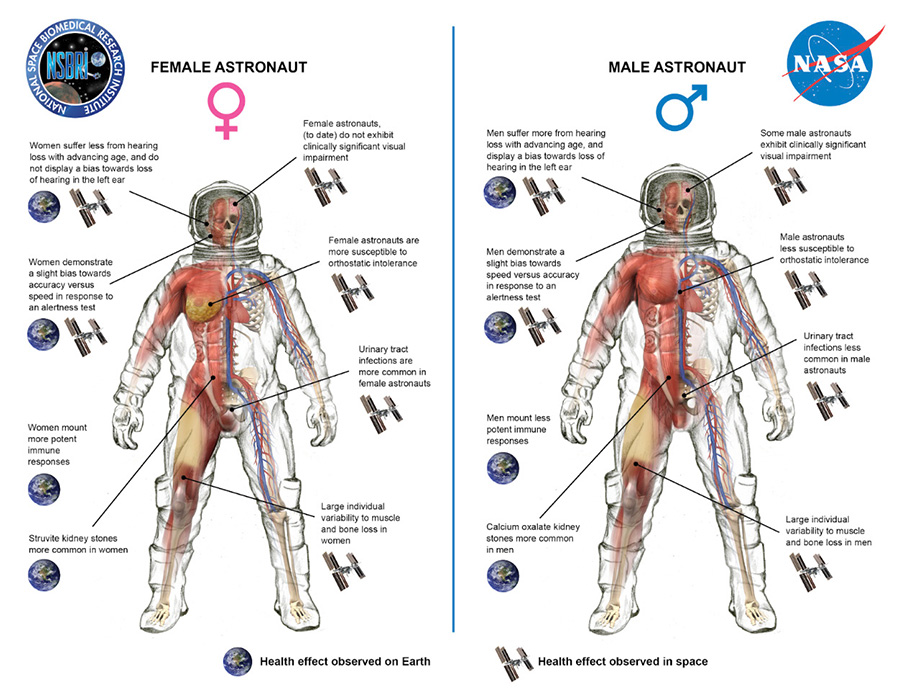
Figure 1: Human’s adaptation within spaceflight5
Space medicine, as defined by Hodgkin et al. (2017), is “the practice of all aspects of preventative medicine including screening, health care delivery, and maintaining human performance in the extreme environment of space [while] preserving the long-term health of space travelers” had become a crucial field to mitigate further space exploration6. The human body evolved within the earth’s climate and was not designed to withstand the drastic change when exposed to the extreme environments of space6. Consequently, the setting of outer space may cause various types of problems towards the human body, such as space radiation, reduced muscle mass, and vision loss5. Nevertheless, outer space’s unique and harsh environment provides opportunities to conduct research that cannot be conducted within earth’s physics, such as studying the effect of microgravity and aging. Studies within space medicine may enable discoveries and applications that lead to better healthcare on earth. Hence, space medicine can contribute to three significant outcomes, which include but are not limited to disease prevention and control; through research into omics and personal hygiene, creating better treatment; via studying drug crystallization and microgravity effects, and solving healthcare problems in Thailand; by examining the aging process and exploring various systems within the human body.
Disease Prevention and Control
Further studies within space medicine enable humanity to better grasp the concept of disease prevention and control. As the frame of preventative medicine shifts towards personalized healthcare, space flight extreme conditions can provide insight regarding the differences between individuals. Omics studies, such as genomics, transcriptomics, proteomics, and metabolomics, excel in space medicine as unique factors that differentiate each individual are amplified in the harsh environment of space7. For instance, to tackle the problem of persistent ocular problems in astronauts after the mission in space, Schmidt M.A. et al.7 utilizes twin studies to study the unique susceptibilities exacerbated by the space flight environment that may result in alteration of one’s carbon metabolism, genetic, and micronutrient attributes. The identical genome comparison allows researchers to isolate the molecular impact of the integrated spaceflight environment toward the human body. Overall, monitoring one’s genotyping, metabolic network assessment, and assessment of essential small molecules in extreme environments accelerate the development of preventative medicine on earth7. As information gathered regarding the field of omics may result in a better understanding to develop countermeasures for diseases, research within space medicine portrays its contribution toward advancing precision medicine8.
Advances in space medicine can be directly translated into better management of pandemics on earth. Cinelli et al. 9 discovered the similarities between space medicine and pandemics, leading to implementable solutions. Thailand is currently suffering from the SAR-COV-2 pandemic. With hospitals reaching their limit, patients are forced to conduct home isolation and monitor their vital signs10. This situation parallels space medicine, as the astronauts in space missions are in an isolated and confined environment. Furthermore, astronauts are highly susceptible to infectious disease due to their impaired immune response, heightened microbial virulence, and limited space within the spacecraft, resulting in strict hygiene countermeasures to control the spread of disease11. Measures utilized to prepare astronauts for long space missions can also apply to COVID-19 patients conducting home isolation. For instance, stress-related sleep deprivation in home isolation patients can adopt astronaut sleep cycles to maintain human function. Additionally, hygiene practices in the international space station are a pragmatic approach for those conducting home quarantine to limit the spread of disease11, ultimately highlighting the knowledge from space medicine and its applicability to improve medical practice in Thailand.
Development of Medical Treatments in Space
Not only does space medicine play a vital role in disease prevention and control, but it is also critical in the development of pharmaceutical processes and research on disease treatments12. The pharmaceutical processes of current interest at the International Space Station (ISS) are the crystallization of drugs and its role in prolonging drug expiration13. In space, the environment is microgravity, which is a status of near weightlessness. This condition allows for minimal convection currents in fluids, which minimizes sedimentation and optimizes protein crystallization, allowing the achievements of high-quality crystals achievable on earth14,15. Crystallization is an essential factor in determining drug properties and delivery. The solid form of a pharmaceutical impacts its solubility, morphology, and dissolution rate, for instance. Poor solubility is a leading challenge in drug development and hinders its clinical usage16,17. Thus, being able to modify drug crystallization in space would allow for a more advanced development of new potent medications for clinical usage. Microgravity had been long recognized and applied to the development of interferon alfa-2b, a cancer drug, as early as the 1900s. It was recognized that the protein had already turned into small uniform sized crystals ideal for delivery of treatment, which led to the improvement of monoclonal antibody pembrolizumab–an oncology drug–resulting in more uniform crystals with better injectability profile14.
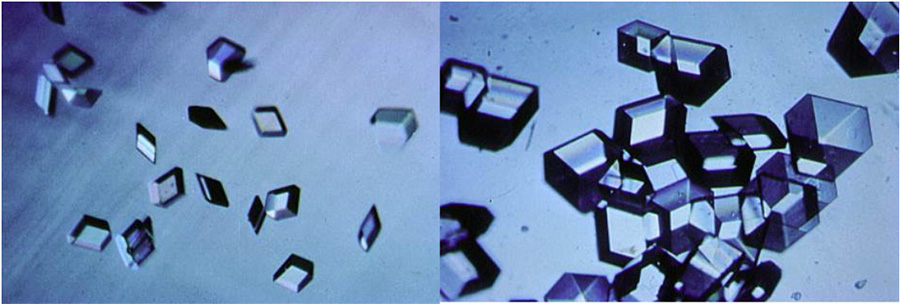
Figure 2. Insulin crystals grown in space (right) results in higher resolution when determining its structure in comparison to insulin crystals grown on earth (left)17.
Ever since the 1900s, multiple research has been conducted to find cancer drugs in space12-15. In 2019, NASA published an update on its revolutionary cancer treatment research at the ISS; a process known as microencapsulation18,19. Microencapsulation is a process that produces biodegradable microcapsules that are small and can be filled with liquid containing antitumor medications20. The microcapsules can be delivered directly to the specific cancerous sites within the patients with small needles. These microcapsules could not be created in a terrestrial environment, but in microgravity, surface tension spontaneously shapes liquids mixture of oil and water into spheres, developing the microcapsules that are now awaiting FDA approval for clinical trials19.
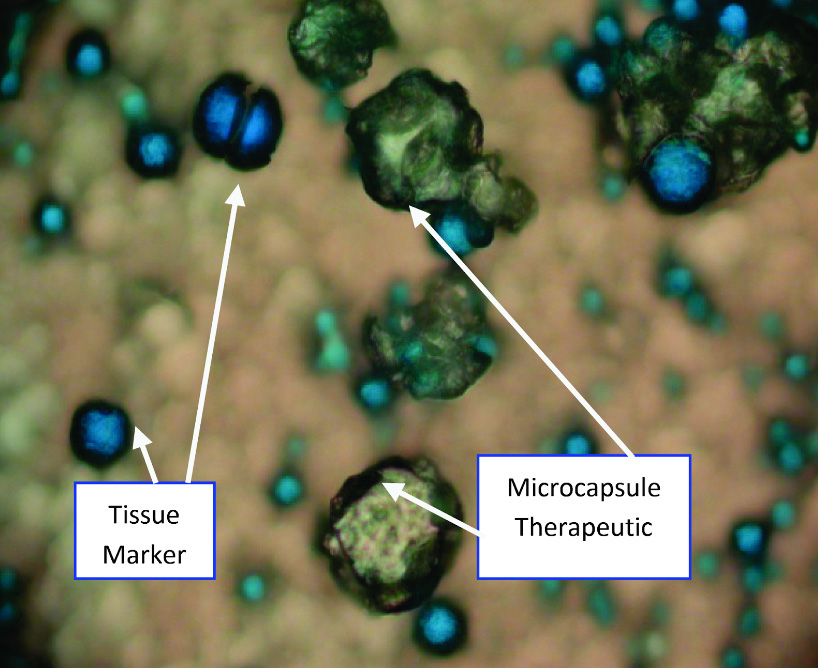
Figure 3. Microcapsule site-specifically delivered to the site of tumor with the tissue marker19.
Pharmaceutical processes are not the only area of interest in space medicine, studying how space traveling affects astronauts also provides better understanding of the human body and disease processes. Astronauts often experience spaceflight osteopenia which consists of bone density loss and decreased muscle mass. Space medicine is not only for astronauts, but it also impacts medical care for everyone on Earth8.
Auñón-Chancellor, an astronaut and practicing physician, has performed a myriad of studies during her space flight that have expanded our understanding of the human body and conducted experiments that have applications in those with cancer, osteoporosis, and Parkinson’s disease21. For instance, samples from blood, urine, saliva, and feces from the astronaut were collected for investigations in research such as the Muscle Tone in Space (Myotones) investigations where the results from this investigation can improve the understanding of human resting muscle tone. This investigation can potentially lead to the development of new rehabilitation treatment for terrestrial medicine22. Medications can also be tested on astronauts with spaceflight osteopenia, which could impact the development of treatment regimens for those on earth with osteoporosis23. Additionally, leucine-rich repeat kinase 2 protein present in patients with Parkinson’s disease was also crystallized in microgravity13. From the research, the protein crystals grew more uniformly and greater in size in space. Such research and analysis of the protein’s structure will ameliorate scientists’ understanding of its role in Parkinson’s and further improve drug development24. To further elaborate on the cancer research that was done in microgravity, Endothelial Cells in Microgravity as a Model System for Evaluation of Cancer Therapy Toxicity (Angiex Cancer Therapy) is another breakthrough that studies the effects of vascular-targeted drugs on normal blood vessels to prevent the process of angiogenesis that leads to cancer metastasis25.
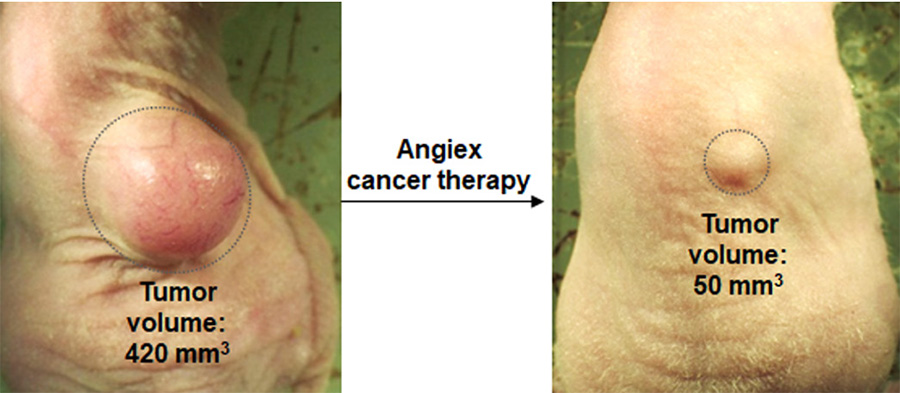
Figure 4. Angiex’s anti-TM4SF1 cancer drug regresses human tumors on the flank of nude mice25.
Research on pharmaceutical processes in microgravity and the application of how space flight affects astronauts to modern medicine accentuate the importance of space medicine in improving terrestrial health care and provide promising breakthroughs to tackle debilitating diseases.
Social Impact of Space Medicine
The difference in the environment on Earth and outer space can be utilized to develop a better understanding of the physiology of the human body, which has the potential to cause a change in the treatment plan with better research. Since astronauts are under a highly controlled environment with much individualization and monitoring, it is an ideal experimental setting to analyze and observe the effects of medications or supplements given. In space, living things are prone to bone loss after extended exposure to microgravity, which can be seen in Figure 6 26 where CT photos of the femur bone of mice are compared between normal gravity (AG) to microgravity (MG). This opens for more possible research and new discoveries of how setting early pharmacologic interventions can help preserve the bone composition27. With further research on which component of the medication is effective along with its mechanism, this has the potential to shine light upon decreasing the number of bed-ridden patients that suffer from bone loss from disuse and those who are prone to bone loss overall28. It is clear that further research is needed for more discoveries, however, this can be influential on how countries like Thailand should handle the current aging population.
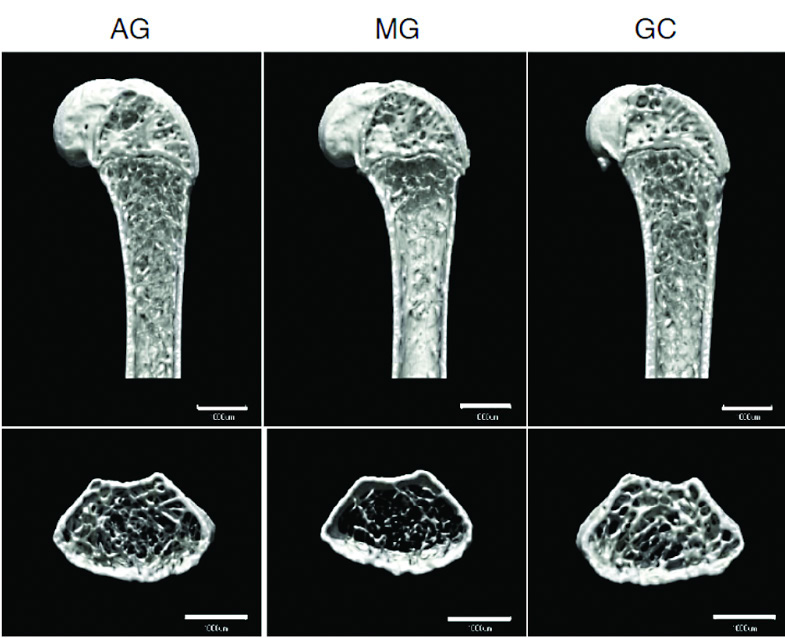
Figure 5. Vertical (upper) and horizontal (lower) sectional microCT photos of the proximal region of the femur26.
Another example that shows how investing in space medicine can be worthwhile, although not confined to the aging population, is being able to understand how mechanical compression on the thorax area can increase left ventricular end-diastolic volume (LVEDV) even with a decreased venous pressure (CVP) with the help of weightlessness in space28. The key was the intrathoracic pressure that was not taken into account. Expansion and compression of the lungs affect CVP and therefore the preload and cardiac output as well which systematically affects LVEDV. In other words, it is not surprising to see an error in the cardiac measurement as position and compression of the thorax were not considered beforehand. Ultimately, they were able to establish a relationship of heart-lung interaction that was never known before. In addition to a better understanding of the cardiovascular system, spaceflight and parabolic flight create an opportunity to study the aging process of the pulmonary system, specifically the ventilation-perfusion mismatch that’s caused by the difference in gravity28.
Space medicine heavily utilizes telemedicine, individualized healthcare, and non-invasive medical devices, and these can be incorporated into medicine on Earth29. Telesurgery and tele-education are new aspects of modern medicine that will greatly increase access to healthcare, especially in rural areas of Thailand where transportation is a problem. By using geographical data from satellite navigation it is possible to analyze and predict, but not limited to, possible communicable diseases’ movement, calling for preventative measures30.
Conclusion:
Space medicine provides a controlled environment suitable for experiments while consisting of various aspects of preventative medicine. There is much to be discovered and learn more about different components of life in an extreme environment with microgravity. From exploring, creating, and accessing the genotyping systems, intrathoracic pressure on the cardiovascular system, protein crystallization, and microencapsulation to conducting experiments involving osteopenia and supplements, aging lung due to perfusion-ventilation mismatch, vascular-targeted drugs, and telemedicine, all of which are valuable information to the medical world19, 25, 26, 28. All of which sets an example of how space med can be utilized to learn more about, not only the overall body system but also the aging aspect as well. In addition to benefiting from space experiments, other aspects of space medicine such as tele-education, communication, and medicine are all extremely applicable on Earth as well. Thailand has always pursued to establish an accessible healthcare system, regardless of location or economic status. However, transportation and time needed is a constant challenge that all must face. By learning and implementing how astronauts are being taken care of despite being light-years away and in an environment prone to cause health problems may be impactful to society in the future8.
As followed from Thailand’s launching of its first satellite, THAICOM, in 1993, health care workers in rural areas were able to communicate better with those in urban areas. This allowed the development of telemedicine and online consultations, consisting of but not limited to, videoconferences and exchange of images, such as radiography. If Thailand invests further into the development of space medicine, the nation will be able to not only enable a more effective telemedicine, especially with the COVID-19 pandemic, but it will also have its own research base for pharmaceutical development as well as cancer research.
References
- Vostok 1. NASA. Published October 28, 2021. Accessed December 14, 2021. https://nssdc.gsfc.nasa.gov/nmc/spacecraft/display.action?id=1961-012A.
- Gunter D K. Thaicom 1, 2. Gunter’s Space Page. Accessed December 14, 2021. https://space.skyrocket.de/doc_sdat/thaicom-1.htm.
- First Thai-made satellite slated for 2023 launch. Accessed December 14, 2021. https://thaiembdc.org/2021/04/21/first-thai-made-satellite-slated-for-2023-launch/.
- Inspiration4: The first all-civilian spaceflight on SpaceX Dragon. Space.com. Published September 23, 2021. Accessed December 14, 2021. https://thaiembdc.org/2021/04/21/first-thai-made-satellite-slated-for-2023-launch/.
- Mahoney E. Study Investigates How Men and Women Adapt Differently to Spaceflight. NASA. Published January 28, 2016. Accessed December 14, 2021. https://www.nasa.gov/content/men-women-spaceflight-adaptation.
- Hodkinson PD, Anderton RA, Posselt BN, Fong KJ. An overview of space medicine. British Journal of Anaesthesia. 2017;119:i143-i153. doi:10.1093/bja/aex336
- Schmidt MA, Goodwin TJ. Personalized medicine in human space flight: using Omics based analyses to develop individualized countermeasures that enhance astronaut safety and performance. Metabolomics. 2013;9(6):1134-1156. doi:10.1007/s11306-013-0556-3
- Schmidt MA, Goodwin T, Cuttino M. Chapter 46 – Personalized Medicine in Space Flight, Part II: Personalized Precision Medicine Approaches. In: Legato MJ, ed. Principles of Gender-Specific Medicine (Third Edition). San Diego: Academic Press; 2017:673-693. doi:10.1016/B978-0-12-803506-1.00064-4
- Cinelli I, Russomano T. Advances in Space Medicine Applied to Pandemics on Earth. Space: Science & Technology. 2021;2021. doi:10.34133/2021/9821480
- Remote care for COVID-19 patients under isolation. สำนักงานหลักประกันสุขภาพแห่งชาติ (สปสช.). Published September 2021. Accessed December 14, 2021. https://eng.nhso.go.th/view/1/DescriptionNews/Remote-care-for-COVID-19-patients-under-isolation/370/EN-US.
- Mermel LA. Infection Prevention and Control During Prolonged Human Space Travel. Clinical Infectious Diseases. 2013;56(1):123-130. doi:10.1093/cid/cis861
- Snell EH, Helliwell JR. Microgravity as an Environment for Macromolecular Crystallization – An Outlook in the Era of Space Stations and Commercial Space Flight. Crystallography Reviews. 2021;27(1):3-46. doi:10.1080/0889311X.2021.1900833
- Amselem S. Remote Controlled Autonomous Microgravity Lab Platforms for Drug Research in Space. Pharm Res. 2019;36(12):183. doi:10.1007/s11095-019-2703-7
- Smith AW. Published Results From Crystallization Experiments on the ISS Could Help Merck Improve Cancer Drug Delivery. The Center for the Advancement of Science in Space. Published December 2, 2019. Accessed December 5, 2021. https://www.issnationallab.org/iss360/merck-lab-publishes-pembrolizumab-results/
- McPherson A, DeLucas LJ. Microgravity Protein Crystallization. npj Microgravity. 2015;1(1):15010. doi:10.1038/npjmgrav.2015.10
- Taylor LS, Braun DE, Steed JW. Crystals and Crystallization in Drug Delivery Design. Crystal Growth & Design. 2021;21(3):1375-1377. doi:10.1021/acs.cgd.0c01592
- Crystallizing Opportunities With Space Station Research. NASA. Published March 4, 2014. Accessed December 5, 2021. https://blogs.nasa.gov/ISS_Science_Blog/2014/03/04/760/
- Cancer Treatment Delivery. NASA. Published January 13, 2010. Accessed December 5, 2021. https://www.nasa.gov/mission_pages/station/research/pfms.html
- Johnson M. Cancer-Targeted Treatments from Space Station Discoveries. NASA. Published March 28, 2019. Accessed December 14, 2021. https://www.nasa.gov/mission_pages/station/research/news/b4h-3rd/hh-cancer-targeted-treatments
- Morrison D, Haddad R. Microencapsulation of Drugs: New Cancer Therapies and Improved Drug Delivery Derived from Microgravity Research. NASA. Published 2011. Accessed December 5, 2021. https://www.nasa.gov/mission_pages/station/research/experiments/explorer/Investigation.html?#id=270
- Serena M. Auñón-Chancellor (M. D.) NASA Astronaut. NASA. Published February 16, 2016. Accessed December 14, 2021. https://www.nasa.gov/astronauts/biographies/serena-m-aunon-chancellor/biography
- Dieter B. Muscle Tone in Space. NASA. Accessed December 14, 2021. https://www.nasa.gov/mission_pages/station/research/experiments/explorer/Investigation.html?#id=7573.
- Genah S, Monici M, Morbidelli L. The Effect of Space Travel on Bone Metabolism: Considerations on Today’s Major Challenges and Advances in Pharmacology. IJMS. 2021;22(9):4585. doi:10.3390/ijms22094585
- Gaskill M. Designing A Key to Unlock Parkinson’s Disease. NASA. Published April 2, 2019. Accessed December 14, 2021. https://www.nasa.gov/mission_pages/station/research/news/parkinsons-research
- Shou-Ching J. Endothelial Cells in Microgravity as a Model System for Evaluation of Cancer Therapy Toxicity. NASA. Accessed December 14, 2021. https://www.nasa.gov/mission_pages/station/research/experiments/explorer/Investigation.html?#id=7502
- Shiba D, Mizuno H, Yumoto A, et al. Development of New Experimental Platform ‘MARS’—Multiple Artificial-Gravity Research System—to Elucidate the Impacts of Micro/Partial Gravity on Mice. Sci Rep. 2017;7(1):10837. doi:10.1038/s41598-017-10998-4
- Lang T, LeBlanc A, Evans H, Lu Y, Genant H, Yu A. Cortical and Trabecular Bone Mineral Loss From the Spine and Hip in Long-Duration Spaceflight. Journal of Bone and Mineral Research. 2004;19(6):1006-1012. doi:10.1359/JBMR.040307
- Shelhamer M, Bloomberg J, LeBlanc A, et al. Selected Discoveries From Human Research in Space That Are Relevant to Human Health on Earth. npj Microgravity. 2020;6(1):1-5. doi:10.1038/s41526-020-0095-y
- Ruyters G, Stang K. Space Medicine 2025 – A Vision: Space Medicine Driving Terrestrial Medicine for the Benefit of People on Earth. REACH. 2016;1:55-62. doi:10.1016/j.reach.2016.06.002
- Dietrich D, Dekova R, Davy S, Fahrni G, Geissbühler A. Applications of Space Technologies to Global Health: Scoping Review. Journal of Medical Internet Research. 2018;20(6):e9458. doi:10.2196/jmir.9458
